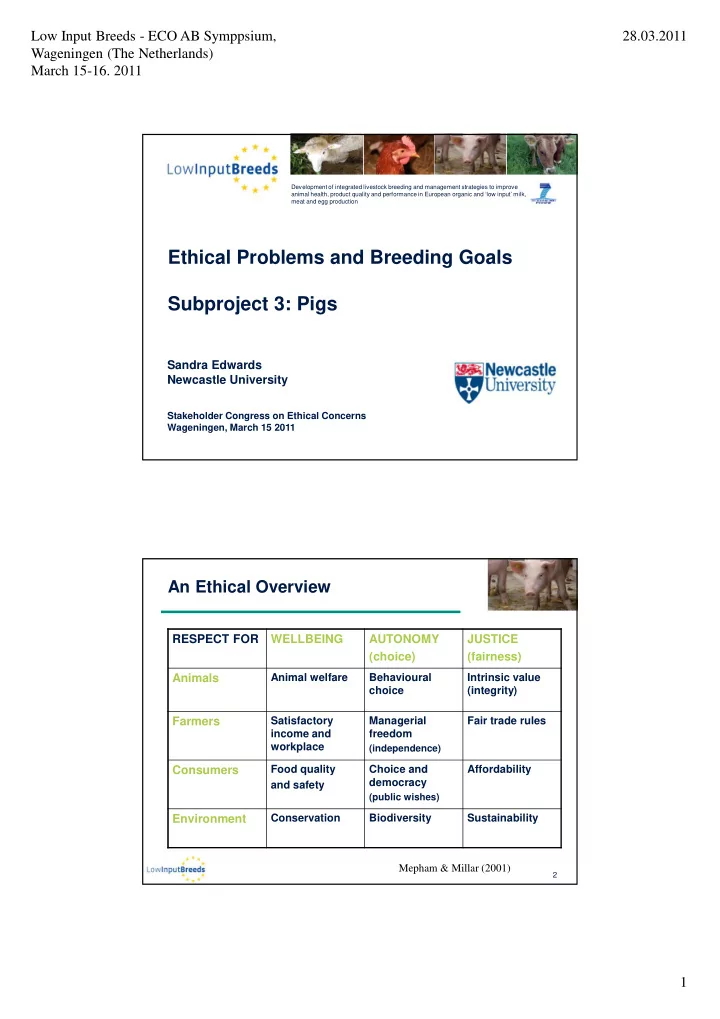

Low Input Breeds - ECO AB Symppsium, 28.03.2011 Wageningen (The Netherlands) March 15-16. 2011 Development of integrated livestock breeding and management strategies to improve animal health, product quality and performance in European organic and ‘low input’ milk, meat and egg production Ethical Problems and Breeding Goals Subproject 3: Pigs Sandra Edwards Newcastle University Stakeholder Congress on Ethical Concerns Wageningen, March 15 2011 An Ethical Overview RESPECT FOR WELLBEING AUTONOMY JUSTICE (choice) (fairness) Animal welfare Behavioural Intrinsic value Animals choice (integrity) Farmers Satisfactory Managerial Fair trade rules income and freedom workplace (independence) Food quality Choice and Affordability Consumers democracy and safety (public wishes) Environment Conservation Biodiversity Sustainability Mepham & Millar (2001) 2 1
Low Input Breeds - ECO AB Symppsium, 28.03.2011 Wageningen (The Netherlands) March 15-16. 2011 Ethical conflicts � Animal welfare v farmer income & affordable food � Animal welfare v management choices � Animal integrity v product quality � Environmental impact v „naturalness“ � Animal integrity v technological advance Breeding? W A J A F C E 3 Income v welfare (1) � Breeding for prolificacy � Piglet survival Breeding? W A J A F C � Neonatal survival of piglet (h 2 = 0.04 - 0.2) E 4 2
Low Input Breeds - ECO AB Symppsium, 28.03.2011 Wageningen (The Netherlands) March 15-16. 2011 Income v welfare (1) � Breeding for prolificacy � Sow longevity 16 14 % sow mortality 12 10 8 6 4 Breeding? 2 0 W A J 20 22 24 26 28 30 A pigs/sow/year F Interpig (2009) C E � Longevity of sow (h 2 = 0.05 - 0.25) 5 Income v welfare (2) � Breeding for lean tissue growth rate � Fast and efficient growth, lean carcass � ? Reduction in Robustness � ? Ability to adapt to low input conditions Breeding? W A J A F C E 6 3
Low Input Breeds - ECO AB Symppsium, 28.03.2011 Wageningen (The Netherlands) March 15-16. 2011 Income v welfare (2) � Breeding for lean tissue growth rate � Metabolic function (ability to function with low quality diets) � Immunological function (natural ability to resist disease) � Skeletal function (predisposition to OCD and leg weakness) Breeding? W A J A F C E 7 Income v welfare (2) � Breeding for lean tissue growth rate � Thermoregulatory function (esp. in low input systems) � Loss of fat insulation (piglets and pregnant sows) � Loss of heat tolerance (finishing pigs and lactating sows) Breeding? W A J LIB project A F Saskia Bloemhof C E 8 4
Low Input Breeds - ECO AB Symppsium, 28.03.2011 Wageningen (The Netherlands) March 15-16. 2011 „Naturalness“ v environmental impact � Feed conversion efficiency � Low input systems use feed less efficiently so give greater environmental impact � Traditional breeds - slower growth, greater fatness � More natural environments – greater waste, climatic penalty Breeding? W A J A F � N.b. Correlates of breeding for efficiency C E 9 Management v welfare (1) � Modified social organisation � Modified group size and composition � Lack of group stability � Breeding for reduced social problems? � Aggression in pigs (h 2 = 0.2 - 0.4) � Tail biting in pigs (h 2 = 0 - 0.3) Breeding? W A J A F C E 10 5
Low Input Breeds - ECO AB Symppsium, 28.03.2011 Wageningen (The Netherlands) March 15-16. 2011 Management v welfare (2) � Restriction of natural behaviour � Early weaning age � Barren housing conditions � Important Ethical issues but not solved by breeding Breeding? W A J A F C E 11 Product quality v integrity � Castration � Mutilation to reduce boar taint in meat � Problem greater in low input systems � traditional, early maturing breeds � slower growth and imbalanced dietary protein Breeding? W A J A F � Boar taint compounds (h 2 = 0.25 - 0.75) C E 12 6
Low Input Breeds - ECO AB Symppsium, 28.03.2011 Wageningen (The Netherlands) March 15-16. 2011 Product quality v Genetic diversity � Fat composition and human health � Fatter animals (traditional breeds) have more saturated fat � Saturated fat increases human health risks � ? Can we breed for unsaturated fatty acids , esp omega-3 Breeding? W A J A F C E 13 Technology v integrity � Genomic selection � Use of genetic markers, SNP information � Not biological (phenotypic) information as used in traditional selection � GM animals � Possibility of enhanced traits for low input systems Breeding? W A J A F C E 14 7
Low Input Breeds - ECO AB Symppsium, 28.03.2011 Wageningen (The Netherlands) March 15-16. 2011 Federal Research Institute ������������� for Rural Areas, Forestry and Fisheries ����������� Institute of Organic ������ Farming - IOF The authors gratefully acknowledge co-funding from the European Commission, under the Seventh Framework Programme for Research and Technological Development, for the Collaborative Project LowInputBreeds (Grant agreement No 222623) 15 15 8
Recommend
More recommend